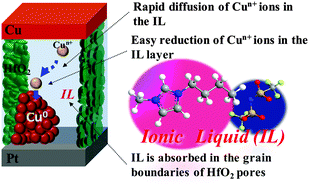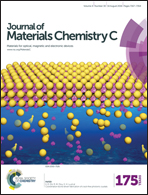Improved performance of a conducting-bridge random access memory using ionic liquids†
Abstract
The conducting-bridge random access memory (CB-RAM) is a promising candidate for the next-generation memory. In this study, the addition effect of 18 types of ionic liquids (ILs) on the performances of the Cu/HfO2/Pt type CB-RAM has been investigated; the switching voltage was lowered by supplying a trace amount of the IL to the HfO2 layer of the Cu/HfO2/Pt cell. It was revealed that the ionic conductivity (σi) of the IL and the coordinating ability (β) of the anion in the IL towards the copper (Cu) ion are key competing factors that determine the voltage required for the formation of the Cu filament (Vset); the increase in σi and the decrease in β are effective in enhancing the ionization and diffusion of the Cu atoms, resulting in the reduction of Vset. Therefore, among the tested ILs, 1-butyl-3-methylimidazolium bis(trifluoromethanesulfonyl)amide ([bmim][Tf2N]), 1-ethyl-3-methylimidazoliumbis(trifluoromethanesulfonyl)amide ([emim][Tf2N]) and 1-butyl-3-methylimidazolium bis(fluorosulfonyl)amide ([bmim][FSA]), which have high σi and low β values were found to be the best additives for the Cu/HfO2/Pt cell. On the other hand, reset was revealed to occur due to the rupture of the Cu filament by the thermal diffusion of the Cu atoms by Joule heat. Reducing Vset and making a thin filament are effective in reducing the reset voltages. We further traced the origin of the improved dispersion of the switching voltages by the addition of the Cu(Tf2N)2 doped [bmim][Tf2N] to the HfO2 film, which we recently reported. A complex-impedance measurement suggested that the addition of Cu doped IL involves two competing factors: the decline of the Cu ion diffusion and enhancement of the Cu ionization. The balance of these two factors determines the important parameters such as Vset and its dispersion. The performance of the CB-RAM can be optimized by the adjustment of the IL, considering the balance of the competing factors revealed by the present study.



 Please wait while we load your content...
Please wait while we load your content...